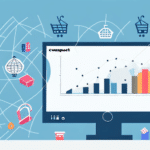Understanding Gross Margin in E-Commerce Operations
In today's fiercely competitive e-commerce landscape, grasping the concept of gross margin is crucial for business owners. Gross margin measures a company's profitability by calculating the difference between revenue and the cost of goods sold (COGS). This metric not only impacts overall profitability but also guides pricing and cost management strategies. This article delves into gross margin, exploring its components, calculation methods, common challenges faced by e-commerce businesses, and strategies to enhance it.
What is Gross Margin and Its Importance for E-Commerce
Gross margin is a key profitability metric that assesses a company's ability to generate profit from sales after accounting for COGS. It is typically expressed as a percentage using the formula:
Gross Margin = (Revenue - COGS) / Revenue × 100%
For e-commerce businesses, understanding gross margin is essential as it provides insights into financial health and informs critical decisions related to pricing, procurement, and cost management.
A healthy gross margin helps identify profitable products, enabling businesses to focus on promoting and expanding those offerings. Additionally, comparing gross margins with industry peers can highlight areas for improvement, such as optimizing pricing strategies or reducing COGS.
According to a [2023 e-commerce report by Statista](https://www.statista.com/), the average gross margin in the e-commerce sector ranges between 30% and 50%, varying based on the industry and business model.
Components of Gross Margin in E-Commerce
Revenue
Revenue refers to the total income generated from selling products and services. It is the starting point for calculating gross margin.
Cost of Goods Sold (COGS)
COGS encompasses all expenses directly related to producing or purchasing the products sold. In e-commerce, this includes:
- Product costs
- Shipping fees
- Packaging expenses
- Inventory management costs
Effective management of COGS is vital for maintaining a healthy gross margin.
Gross Profit
Gross profit is the difference between revenue and COGS:
Gross Profit = Revenue - COGS
This figure indicates the amount available to cover operating expenses and contribute to net profit.
Calculating Gross Margin: Formulas and Examples
Calculating gross margin is straightforward. Here’s the formula again:
Gross Margin = (Revenue - COGS) / Revenue × 100%
Example: If a company generates $150,000 in revenue and incurs $90,000 in COGS, the gross margin is:
(150,000 - 90,000) / 150,000 × 100% = 40%
A gross margin of 40% indicates that for every dollar earned, 40 cents contribute to covering operating expenses and profits.
Challenges in Maintaining a Healthy Gross Margin
E-commerce businesses often face several hurdles in sustaining robust gross margins:
Managing COGS
Fluctuating supplier costs, shipping fees, and inventory management inefficiencies can erode gross margins. Businesses must continually negotiate favorable terms with suppliers and seek cost-effective shipping solutions.
Marketing and Advertising Expenses
High marketing spend can reduce gross profit. Balancing customer acquisition costs with revenue growth is essential to maintain healthy margins.
Returns and Refunds
While a lenient return policy enhances customer satisfaction, it can lead to increased costs and reduced margins. Implementing effective return management strategies is crucial.
Strategies to Improve Gross Margin in E-Commerce
Enhancing gross margin involves a combination of cost management and strategic pricing:
Strategic Procurement
Negotiate better terms with suppliers, reduce shipping costs, and optimize inventory levels to lower COGS.
Pricing Strategies
Ensure products are priced to cover COGS while remaining competitive. Consider tiered pricing, bundling, and offering premium products to boost margins.
Customer Retention
Focusing on customer loyalty can lead to repeat purchases at full price, reducing the need for discounts and maintaining higher margins.
Optimizing Operational Efficiency
Streamline operations through automation, efficient inventory management, and reducing waste to lower overall costs.
The Role of Pricing Strategy in Maximizing Gross Margin
Effective pricing strategies are pivotal in enhancing gross margins. E-commerce businesses should adopt strategies that reflect both variable and fixed costs while remaining responsive to market conditions.
Dynamic Pricing
Utilize dynamic pricing tools to adjust prices in real-time based on demand, competition, and inventory levels. This approach can help maximize revenue and maintain optimal margins.
Value-Based Pricing
Set prices based on the perceived value to the customer rather than solely on cost-plus models. This can justify higher prices and improve margins.
Promotional Strategies
Implement targeted promotions that encourage higher purchase volumes without significantly impacting margins. For example, offering discounts on bulk purchases or bundling products.
Tools and Techniques for Analyzing Gross Margin Trends
To effectively monitor and improve gross margins, e-commerce businesses can employ various tools and techniques:
Financial Reporting Tools
Use accounting software like QuickBooks or Xero to generate detailed financial reports that track revenue and COGS over time.
Data Analytics Platforms
Leverage platforms such as Tableau or Power BI to visualize data trends and identify patterns that can inform strategic decisions.
Forecasting Models
Implement forecasting tools to predict future gross margins based on historical data and market trends. This aids in proactive planning and strategy adjustments.
Benchmarking Gross Margin: Best Practices
Benchmarking against industry standards helps e-commerce businesses gauge their performance and identify improvement areas:
- Compare your gross margin with industry averages using reports from sources like Bain & Company or PwC.
- Analyze competitors’ pricing and cost structures to find opportunities for optimization.
- Set realistic margin targets based on benchmarking insights and continuously monitor progress.
Case Studies: Successful Gross Margin Management in E-Commerce
Examining real-world examples can provide valuable insights into effective gross margin management:
Amazon
Amazon employs dynamic pricing algorithms to adjust product prices based on demand and competition, ensuring optimal margins. Additionally, their efficient fulfillment network reduces shipping costs, contributing to higher gross margins.
Zappos
Zappos focuses on exceptional customer service and a seamless shopping experience, fostering customer loyalty and repeat business. This strategy minimizes the need for heavy discounting, thereby maintaining healthy gross margins.
These examples demonstrate the importance of combining strategic pricing, cost management, and customer-centric approaches to enhance gross margins in e-commerce.
Conclusion
Understanding and optimizing gross margin is vital for the success of e-commerce businesses. By accurately measuring gross margin, managing costs effectively, and implementing strategic pricing, businesses can enhance profitability and achieve sustainable growth in a competitive market.




















